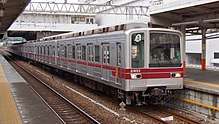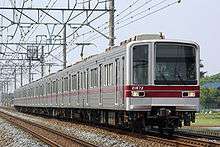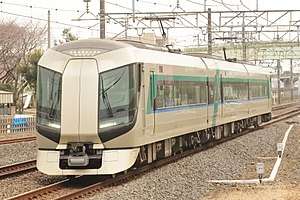Tobu 20000 series
| Tobu 20000 series | |
|---|---|
|
20000 series set 21807 in June 2008 | |
| Manufacturer | Alna Kōki, Tokyu Car Corporation |
| Built at | Amagasaki, Yokohama |
| Replaced | 2000 series |
| Constructed | 1988–1997 |
| Entered service | 25 March 1988 |
| Scrapped | 2017– |
| Number built | 192 vehicles (24 sets) |
| Number in service | 192 vehicles (24 sets) (as of 1 April 2017) |
| Formation | 8 cars per trainset |
| Operator(s) | Tobu Railway |
| Depot(s) | Kasukabe |
| Line(s) served | Tobu Skytree Line, Tobu Nikko Line, Tokyo Metro Hibiya Line |
| Specifications | |
| Car body construction | Stainless steel |
| Car length | 18,000 mm (59 ft 1 in) |
| Width | 2,857 mm (9 ft 4.5 in) |
| Doors | 3/5 pairs per side |
| Maximum speed | 100 km/h (60 mph)[1] |
| Acceleration | 3.3 km/h/s |
| Deceleration | 3.7 km/h/s (service), 4.5 km/h/s (emergency) |
| Electric system(s) | 1,500 V DC |
| Current collection method | Overhead line |
| Safety system(s) | Tobu ATS |
| Track gauge | 1,067 mm (3 ft 6 in) |
The Tobu 20000 series (東武20000系 Tōbu 20000-kei) is a DC electric multiple unit (EMU) commuter train type operated by the private railway operator Tobu Railway in Japan since 1988.[2]
The 20000 series fleet is scheduled to be replaced by new Tobu 70000 series EMUs with 20 m cars, but as of 1 April 2016, all 24 sets (192 vehicles) built were still in service.[3]
Variants
- 20000 series: 13 x 8-car sets introduced from March 1988
- 20050 series: 8 x 8-car sets introduced from December 1992 with 5-door cars
- 20070 series: 3 x 8-car sets introduced from March 1997
20000 series
Thirteen eight-car sets (21801 to 21813) were built to replace the ageing 2000 series trains on inter-running services between the Tobu Skytree Line and the Tokyo Metro Hibiya Line in Tokyo, entering service on 25 March 1988. The body design uses a new lightweight corrugated stainless steel construction.[2] These trains use the same AFE (Automatic Field Excite) chopper control as the earlier Tobu 9000 series trains, bolsterless bogies.[4]
Total number of vehicles built: 104[2]
Formation
Trains are formed as follows, with six motored ("M") cars and two non-powered driving trailer ("Tc") cars.[5]
| Designation | Tc1 | M1 | M2 | M1 | M3 | M1 | M4 | Tc2 |
|---|---|---|---|---|---|---|---|---|
| Numbering | 21800 | 22800 | 23800 | 24800 | 25800 | 26800 | 27800 | 28800 |
The M1 cars are each fitted with one scissors type pantograph.[5]
20050 series

Eight eight-car sets (21851 to 21858) were introduced on 29 December 1992 on Tobu Isesaki Line (present-day Tobu Skytree Line) and Tokyo Metro Hibiya Line inter-running services. These sets feature two five-door cars at each end, and also LED destination indicators.[2] These sets have VVVF control.[1]
Total number of vehicles built: 64[2]
Formation
Trains are formed as follows, with six motored ("M") cars and two non-powered driving trailer ("Tc") cars.[5]
| Designation | Tc3 | M5 | M2 | M7 | M3 | M7 | M6 | Tc4 |
|---|---|---|---|---|---|---|---|---|
| Numbering | 21850 | 22850 | 23850 | 24850 | 25850 | 26850 | 27850 | 28850 |
The M5 and M7 cars are each fitted with one scissors type pantograph.[5]
Interior
Passenger accommodation consists of longitudinal bench seating throughout, with seats for three persons between each pair of doors in the five-door cars.[4] Seat width is 440 mm (17 in) per person for the three-person bench seats in five-door cars and 450 mm (18 in) per person for the ten-person bench seats in three-door cars.[4] As with the 9050 series EMUs introduced around the same time, these sets featured LCD passenger information screens above the doorways, but these were subsequently removed.[4]
20070 series

Three eight-car sets (21871 to 21873) were introduced from 25 March 1997 to cope with an increased service frequency. These sets feature three-door cars throughout, and also LED destination indicators.[2] These sets have VVVF control.[1]
Total number of vehicles built: 24[2]
Formation
Trains are formed as follows, with six motored ("M") cars and two non-powered driving trailer ("Tc") cars.[5]
| Designation | Tc1 | M1 | M2 | M3 | M4 | M3 | M5 | Tc2 |
|---|---|---|---|---|---|---|---|---|
| Numbering | 21870 | 22870 | 23870 | 24870 | 25870 | 26870 | 27870 | 28870 |
The M1 and M3 cars are each fitted with one single-arm pantograph.[5]
Interior
Passenger accommodation consists of longitudinal bench seating throughout. These sets feature three-colour LCD passenger information displays above alternate doorways.[4]
Withdrawal
The 20000 series trains began to be replaced by new 70000 series trains from 7 July 2017.[6] The first set to be withdrawn, set (21813 and 21809), was removed for scrapping in July 2017.[7]
References
- 1 2 3 私鉄車両年鑑2015 [Japan Private Railways Annual 2015] (in Japanese). Tokyo, Japan: Ikaros Publications Ltd. 20 June 2015. p. 148. ISBN 978-4-8022-0003-5.
- 1 2 3 4 5 6 7 2006東武鉄道通勤車両カタログ [2006 Tobu Railway Commuter Rolling Stock Catalogue]. Tetsudo Daiya Joho Magazine. Vol. 35 no. 263. Japan: Kotsu Shimbun. March 2006. pp. 16–20.
- ↑ 私鉄車両編成表 2016 [Private Railway Rolling Stock Formations - 2016] (in Japanese). Japan: Kotsu Shimbunsha. 25 July 2016. p. 39. ISBN 978-4-330-70116-5.
- 1 2 3 4 5 東武鉄道の世界: 身近な鉄路の"本格派"雑学 東武鉄道の世界 [The World of Tobu Railway] (in Japanese). Japan: Kotsu Shimbunsha. 8 April 2015. p. 41–43. ISBN 978-4-330-54215-7.
- 1 2 3 4 5 6 私鉄車両編成表 私鉄車両編成表 2010 [Private Railway Rolling Stock Formations - 2010]. Japan: JRR. August 2010. p. 36. ISBN 978-4-330-15310-0.
- ↑ http://www.tobu.co.jp/file/pdf/fff044630876dab31fd1ef42f8e0c589/170622新型車両70000系運行開始【HP用確定版】.pdf?date=20170622170923%5Bpermanent+dead+link%5D
- ↑ "東武鉄道20000系が渡瀬へ|鉄道ニュース|2017年7月29日掲載|鉄道ファン・railf.jp".
External links
| Wikimedia Commons has media related to Tobu 20000 series. |
- Tobu 20000 series (in Japanese)
